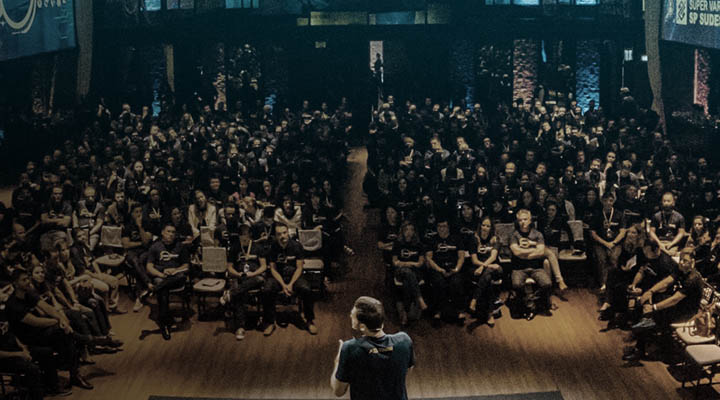The race for banks to adopt digital technology is on. More than ever, traditional US banks are under pressure to introduce new digital technologies and agile ways of working to cope with increasing competition from digital banks and fintechs. Evolving customer needs and rising expectations are further compounding this urgency.
As the BJSS White Paper, the three things banks must do to thrive in 2021 states, “Digital technology will be the primary driver of business success.” The pandemic has accelerated this adoption. But this is not static, and the bar continues to rise as the economy further embraces digital technology and GenZ pervades the population.
As a result, customers now see digital banking channels as the bare minimum, and they increasingly expect compelling and personalized interactions across digital and physical channels.
Bill Kamman and I participated in the American Banker Digital Banking 2022 in Austin, Texas, to learn more about these trends. Over 1,000 attendees came to the event, representing a range of major, medium, and small banks, including Citi, US Bank, People’s United Bank, USAA, Mastercard, and Cross River Bank.
Although the core banking vendors were in attendance, the interesting discussions were with the smaller fintech companies, especially those focusing on improving the client experience (CX).
In this post, I have distilled my observations from this conference into six themes. I have considered my comments based on working in banking for more than 20 years. Each theme applies to any size US-based bank. They set out a list of primary considerations when a bank embraces multi-channel digital delivery of services through multiple places (online, IoT, stores, branches, lawyers, etc.). Ignoring them could impair client satisfaction, growth, and operational efficiency.
The top priority is improving the customer experience
Almost every session highlighted the importance of enhancing the customer experience.
US Bank talked about how they embarked on a digital transformation four years ago to enhance their customers’ lives, understanding that managing money is the means to an end, not the goal.
US Bank demonstrated how they use mobile technology to build personal relationships with each customer. For example, customers can call their local banker using their cell phone and enrich the interaction through video and controlled screen sharing.
US Bank also organized financial transactions under sections called “life moments,” such as buying a house, getting married, or having a child.
Research from Arizen (parent company of American Banker) shows that banks primarily adopt a digital strategy to improve their client experience, not to grow their business and improve operational efficiency. However, banks have discovered that enhancing the customer experience can stimulate growth and create more efficient operations. These learnings echo what we found at the Digital Transformation in Insurance Conference earlier this year.
Fintech partnerships are increasing in priority
Although not explicitly said, a prominent theme across many panel discussions and talks was that the most common approach towards digital transformation was the integration of fintech service offerings with existing core bank services.
For example, banks are not replacing their core banking systems to deliver a digital experience. Instead, they’re enhancing their core banking systems and integrating them with an existing solution typically built by a fintech.
US Bank called out their fintech partners as being critical to their success. Although banks need fintech companies, the latter needs access to capital to grow, which they can obtain through a bank partnership. It’s, therefore, a win-win scenario for both the banks and the fintechs.
Additionally, banks don’t want fintechs to disintermediate them from their customers.
I noted many fintechs in the exhibit hall, ranging from broad support services, like Glance and Akoya, to bank service-specific offers, such as PAYVERIS (A Division Of Payments). for payments and QuickFi (by Innovation Finance USA). for equipment finance.
Requires an innovative approach outside mainstream operations
Banks often approach the digital transformation of their services as innovative projects outside their core operations. Instead of replacing their banking services, banks enhance them by integrating third-party fintech services.
An Executive Editor from American Banker moderated a panel that included representatives from Amplify Credit Union, Wells Fargo, Citi Ventures, and Temenos. The session commenced with a discussion on the McKinsey paper, Fear factor: Overcoming human barriers to innovation. The panel covered four issues:
- the need to create a culture that is not risk-averse and allows for failures,
- the importance of ongoing integrated conversations to understand the business and what has and has not worked in the past,
- including PRC (people, risk, and compliance) from the start, and
- being agile.
Citi Ventures spoke about how they create “permissive spaces” where failure is allowed. Their employees are encouraged to take risks and measure positive impacts on the business. Citi Ventures is separate from the core bank and is tied to a growth agenda.
Needs a service-based architecture
One of the critical challenges in deploying a new client-facing service is integrating them with existing back-office systems, including transaction processing, monitoring, and risk controls.
The CEO of a credit union discovered that deploying a new service requires integrating it with 17 backend systems. Other panelists agreed that any new service must integrate with many existing systems.
One session focused on the importance of defining standard interfaces overseen by a Digital Architecture Review Board under the governance of a Digital Steering Committee. This includes a clear definition of services, their Application Programming Interface (API), and deployment across a “service bus.”
Banking architecture must embrace personalization in a consistent, scalable, always available, responsive, and secure way to deliver a compelling digital experience.
Blockchain evolves
There were a couple of sessions on crypto and digital banking. Mike Cagney, CEO of Figure Technologies, predominantly focused his interview on the topic. We also attended a session on payments, where we heard about several blockchain-based payment networks that were tested, but none succeeded.
Mike views blockchain as a means to “replace trust with the truth” by replacing multilateral with bilateral transactions.
A transaction on a blockchain allows two counterparties to directly complete a transaction without an intermediary, eliminating counterparty risk.
Mike also talked about DEX (decentralized exchanges) as new types of payment networks that present an existential threat to central banks, which is why central banks are exploring digital currencies. He sees value in placing assets on a blockchain, such as mortgages and loans.
There continues to be considerable hype about blockchain and limited experimental testing for select banking use cases, but banking is yet to find a valuable blockchain use case.
As per Mike Cagney comments, trade finance appeared to be a great use case because it requires considerable paper exchange between many banks, but it proved more expensive than traditional methods. Banks should continue to monitor blockchain development but should not adopt it unless there is a compelling use case that does not introduce excessive risk to the bank.
But one key theme was missing
One theme not emphasized at the conference was open industry standards in banking. It was discussed, but not as a critical enabler or barrier. This is not a new topic and has been discussed for years. A key reason for the lack of an open banking standard is the lack of regulatory support, such as the Open Banking Standard in the UK.
A couple of sessions discussed Banking as a Service (BaaS), but no significant announcements or innovations were covered. Although Akoya attended and exhibited at the conference, the Financial Data Exchange (FDX) did not exhibit, speak or participate in a panel discussion.
I spoke to several conference participants, and none mentioned open standards as an issue. I would think that open standards would facilitate the integration of core banking with fintech, which is Akoya’s target space.
Conclusion
What’s evident from attending the event is that banks must knuckle down and focus on improving their client experience to prevent loss of business and diversify their services.
To accomplish this, banks must embrace and deliver a digital strategy in an agile manner. To do that, banks need to create an environment that promotes experimentation, allows failure to build new experiences, and introduces open service-based architecture with well-defined APIs.
BJSS in Financial Services
BJSS has helped many banks embark on their digital transformation. We collaborated with Barclays Ventures to deliver the rapid ventures Zone (RVZ), their platform to introduce digital technology and agile ways of working to the bank.
The BJSS design team is experienced in using customer research and human-centered design to develop compelling customer and employee experiences.
Our engineering and delivery teams support our clients in enhancing their core banking systems and legacy architectures into real-time service-based open architectures.
Published
April 29, 2024Reading time
5 minutesRelated posts





